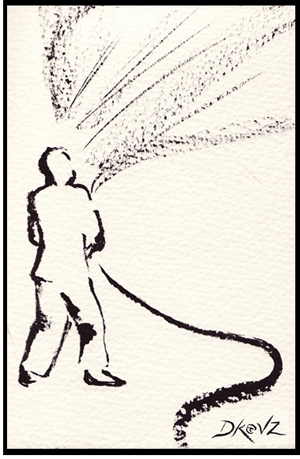 Pre-Internet, most people got their news from a media pipeline: a daily paper or an evening news broadcast. Media performed as a gatekeeper between information sources and the public. Today, with billions of news sources available, the pipeline has become a firehose, and it is almost impossible to keep up with the information drenching us at all times.
Pre-Internet, most people got their news from a media pipeline: a daily paper or an evening news broadcast. Media performed as a gatekeeper between information sources and the public. Today, with billions of news sources available, the pipeline has become a firehose, and it is almost impossible to keep up with the information drenching us at all times.
Master Sumi e-artist, Drue Kataoka at ValleyZen created this image of a man seen from behind, drinking (or trying to drink) from a firehose spewing water. The water is coming out at an uncontrollable speed and the force nearly pushes him backwards. “The hose,” she wrote in an IM, “is almost like a media cable, and symbolizes the struggle between traditional news sources and Internet technology and its decentralization of content delivery.”
In our current media age, everyone has the ability to publish information, and media has become a firehose spewing information at uncontrollable speed. Trying to keep up with the spewing water is a full-time, and practically impossible job. (Follow our series, Top Bloggers Essential Research Tools, to see how many of the digerati keep up with news.)
The transformative technological change of new media is that the news cycle is now continual. “News is what happened hours ago, minutes ago, what is developing right now. Now we not only hear what bomb has been exploded in the last five minutes but also see it. In fact, we can see it on numerous channels. It is a competitive sport for media channels to beat the others to the punch if by minutes or seconds.” Three month old news is history.
While blogs proliferate commentary, it is generally of other writers’ work – often mainstream media. However, eventually, technology will devise a measure of information credibility.
The observations are part of a post called Drinking From the Media Firehose, that Kataoka wrote with co-blogger Bill Fenwick after the two attended the “Legal Futures Conference” at Stanford Law School, sponsored by Google and Stanford Law School’s Center for Internet and Society.
Today, there are billions of news broadcasters (TV channels, radio stations, hardcopy publications, and blogs). To meet the demand for a constant stream of new information, many news and entertainment purveyors have started “borrowing YouTube, FaceBook and blogger content,” the post continues. “Those believing in the principles of evolution and not understanding the Zen principles must, at some point start wondering if they are a threatened species,” they note.
So while blogs proliferate commentary, in general they create much less original content than the traditional media… based on the laws of economics one may predict that in the coming years the balance of power can shift away from the commentators and channels, and towards the media content creators.
Technology, they conclude, “will continue to make it easier to publish and disseminate information and content will grow exponentially. The good news: technology will also eventually devise a measure of content credibility.”
That can’t happen soon enough for me.
Related: What Journalistic Responsibility Do Bloggers Have? Posted by B.L. Ochman








At ValleyZen it has been most rewarding to see other bloggers pick up particular stories or quote us in the context of their own posts. This is the best of the collaborative nature of the web. Thanks for taking an interest in our post “Drinking from the Media Firehose.”
Great blog B.L. Keep up the great work! What’s Next is an apt name for your blog.